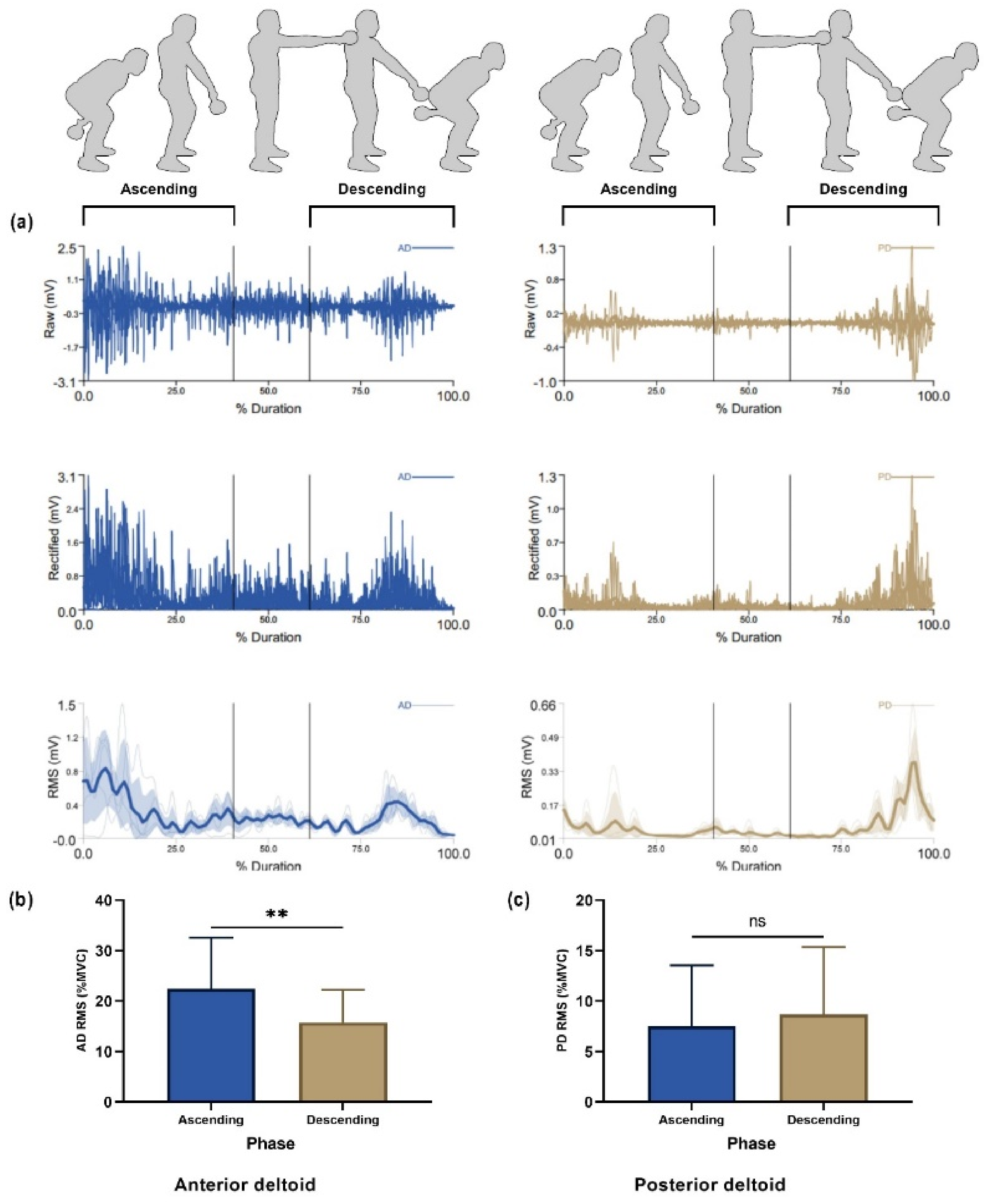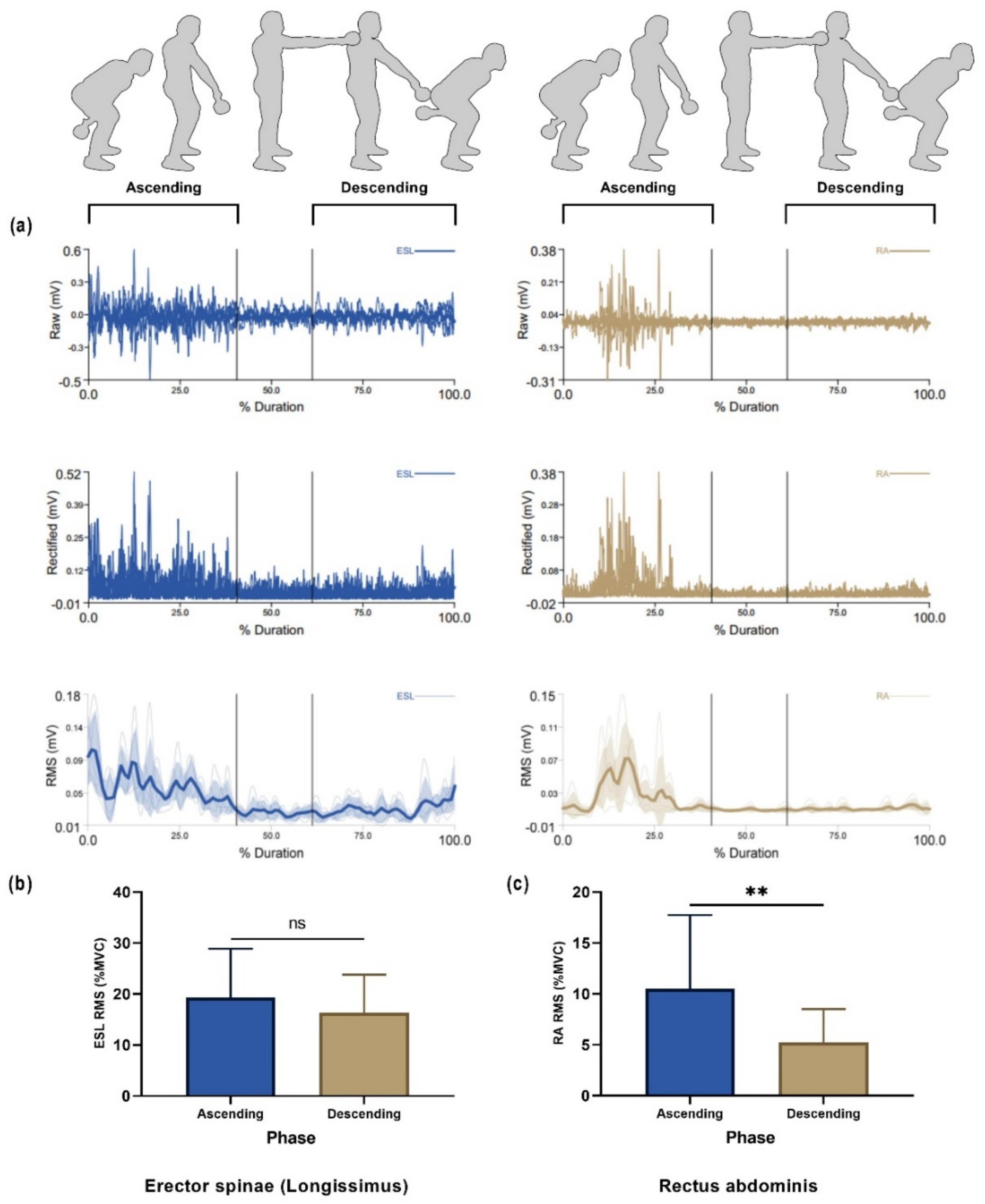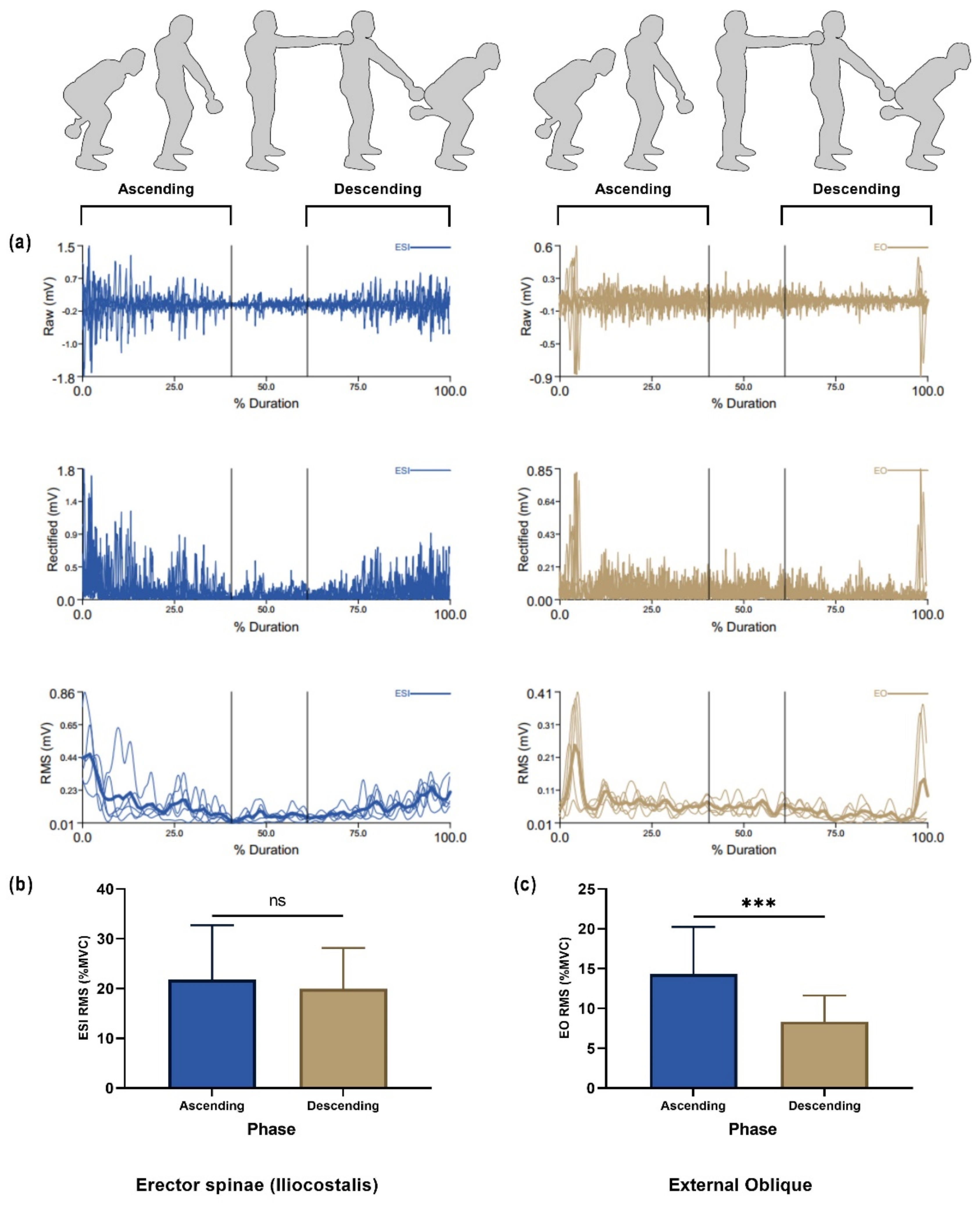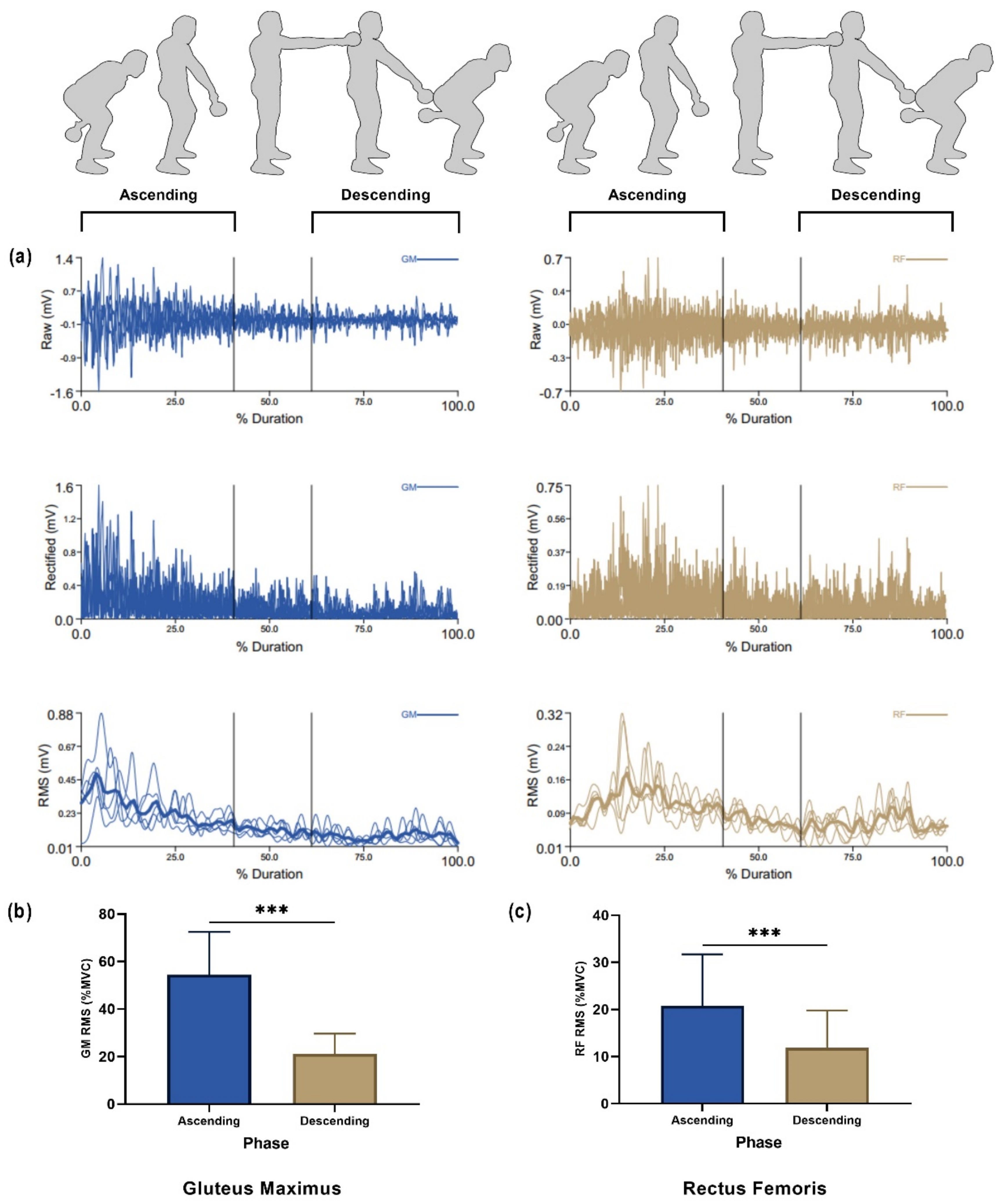Antagonist Muscle Co-Activation during Kettlebell Single Arm Swing Exercise
Abstract
:1. Introduction
2. Materials and Methods
2.1. Participants
2.2. Experiment Protocol
2.3. Data Recordings
2.4. Co-Activation Index
2.5. Statistical Analysis
3. Results
3.1. Muscular Activity
3.2. Co-Activation Index
4. Discussion
5. Conclusions
Author Contributions
Funding
Institutional Review Board Statement
Informed Consent Statement
Data Availability Statement
Acknowledgments
Conflicts of Interest
References
- Andersen, V.; Fimland, M.S.; Gunnarskog, A.; Jungard, G.A.; Slattland, R.A.; Vraalsen, O.F.; Saeterbakken, A.H. Core muscle activation in one-armed and two-armed kettlebell swing. J. Strength Cond. Res. 2016, 30, 1196–1204. [Google Scholar] [CrossRef] [PubMed]
- McGill, S.M.; Marshall, L.W. Kettlebell swing, snatch, and bottoms-up carry: Back and hip muscle activation, motion, and low back loads. J. Strength Cond. Res. 2012, 26, 16–27. [Google Scholar] [CrossRef] [PubMed]
- Jay, K.; Frisch, D.; Hansen, K.; Zebis, M.K.; Andersen, C.H.; Mortensen, O.S.; Andersen, L.L. Kettlebell training for musculoskeletal and cardiovascular health: A randomized controlled trial. Scand. J. Work Environ. Health 2011, 37, 196–203. [Google Scholar] [CrossRef] [PubMed] [Green Version]
- Baek, H.-Y.; Seol, S.-J.; Lee, D.-Y.; Hong, J.-H.; Yu, J.-H.; Kim, J.-S. A comparison of muscle activity depending on shoulder joint flexion angle when conducting kettle bell swing. Med. Leg. Update 2020, 20, 1783–1787. [Google Scholar]
- Van Gelder, L.H.; Hoogenboom, B.J.; Alonzo, B.; Briggs, D.; Hatzel, B. EMG analysis and sagittal plane kinematics of the two-handed and single-handed kettlebell swing: A descriptive study. Int. J. Sports Phys. Ther. 2015, 10, 811–826. [Google Scholar] [PubMed]
- Lake, J.P.; Lauder, M.A. Mechanical demands of kettlebell swing exercise. J. Strength Cond. Res. 2012, 26, 3209–3216. [Google Scholar] [CrossRef] [PubMed]
- Comerford, M.J.; Mottram, S.L. Functional stability re-training: Principles and strategies for managing mechanical dysfunction. Man. Ther. 2001, 6, 3–14. [Google Scholar] [CrossRef] [PubMed]
- Yamazaki, Y.; Suzuki, M.; Ohkuwa, T.; Itoh, H. Coactivation in arm and shoulder muscles during voluntary fixation of a single joint. Brain Res. Bull. 2003, 59, 439–446. [Google Scholar] [CrossRef]
- Meigh, N.J.; Keogh, J.W.L.; Schram, B.; Hing, W.A. Kettlebell training in clinical practice: A scoping review. BMC Sports Sci. Med. Rehabil. 2019, 11, 19. [Google Scholar] [CrossRef] [PubMed] [Green Version]
- Hermens, H.J.; Freriks, B.; Disselhorst-Klug, C.; Rau, G. Development of recommendations for SEMG sensors and sensor placement procedures. J. Electromyogr. Kinesiol. 2000, 10, 361–374. [Google Scholar] [CrossRef]
- Kellis, E.; Arabatzi, F.; Papadopoulos, C. Muscle co-activation around the knee in drop jumping using the co-contraction index. J. Electromyogr. Kinesiol. 2003, 13, 229–238. [Google Scholar] [CrossRef]
- Mitchell, J.; Johnson, W.M.; Riemann, B.; Krajewski, K.; Coates, C.W. Biomechanical Loading of the American Kettlebell Swing. In Proceedings of the ASME International Mechanical Engineering Congress and Exposition, Volume 3: Biomedical and Biotechnology Engineering, Houston, TX, USA, 13–19 November 2015. [Google Scholar] [CrossRef]
- Franz, J.R.; Kram, R. How does age affect leg muscle activity/coactivity during uphill and downhill walking? Gait Posture 2013, 37, 378–384. [Google Scholar] [CrossRef] [PubMed] [Green Version]
- Cholewicki, J.; McGill, S.M. Mechanical stability of the in vivo lumbar spine: Implications for injury and chronic low back pain. Clin. Biomech. 1996, 11, 1–15. [Google Scholar] [CrossRef]
- Brown, S.H.; Potvin, J.R. Constraining spine stability levels in an optimization model leads to the prediction of trunk muscle cocontraction and improved spine compression force estimates. J. Biomech. 2005, 38, 745–754. [Google Scholar] [CrossRef] [PubMed]
- Brown, S.H.; McGill, S.M. Co-activation alters the linear versus non-linear impression of the EMG-torque relationship of trunk muscles. J. Biomech. 2008, 41, 491–497. [Google Scholar] [CrossRef] [PubMed]
- Lee, P.J.; Granata, K.P.; Moorhouse, K.M. Active trunk stiffness during voluntary isometric flexion and extension exertions. Hum. Factors 2007, 49, 100–109. [Google Scholar] [CrossRef] [PubMed]
- Van Dieën, J.H.; Cholewicki, J.; Radebold, A. Trunk muscle recruitment patterns in patients with low back pain enhance the stability of the lumbar spine. Spine 2003, 28, 834–841. [Google Scholar] [CrossRef] [PubMed]
- French, H.P.; Dunleavy, M.; Cusack, T. Activation levels of gluteus medius during therapeutic exercise as measured with electromyography: A structured review. Phys. Ther. Rev. 2010, 15, 92–105. [Google Scholar] [CrossRef]





Publisher’s Note: MDPI stays neutral with regard to jurisdictional claims in published maps and institutional affiliations. |
© 2021 by the authors. Licensee MDPI, Basel, Switzerland. This article is an open access article distributed under the terms and conditions of the Creative Commons Attribution (CC BY) license (https://creativecommons.org/licenses/by/4.0/).
Share and Cite
Salem, A.; Hassan, A.; Tilp, M.; Akl, A.-R. Antagonist Muscle Co-Activation during Kettlebell Single Arm Swing Exercise. Appl. Sci. 2021, 11, 4033. https://doi.org/10.3390/app11094033
Salem A, Hassan A, Tilp M, Akl A-R. Antagonist Muscle Co-Activation during Kettlebell Single Arm Swing Exercise. Applied Sciences. 2021; 11(9):4033. https://doi.org/10.3390/app11094033
Chicago/Turabian StyleSalem, Ahmed, Amr Hassan, Markus Tilp, and Abdel-Rahman Akl. 2021. "Antagonist Muscle Co-Activation during Kettlebell Single Arm Swing Exercise" Applied Sciences 11, no. 9: 4033. https://doi.org/10.3390/app11094033
APA StyleSalem, A., Hassan, A., Tilp, M., & Akl, A.-R. (2021). Antagonist Muscle Co-Activation during Kettlebell Single Arm Swing Exercise. Applied Sciences, 11(9), 4033. https://doi.org/10.3390/app11094033








